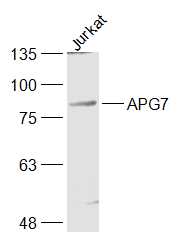
Figure 1. Western blot analysis of APG7 using anti-APG7 antibody (PB9479). Electrophoresis was performed on a 5-20% SDS-PAGE gel at 70V (Stacking gel) / 90V (Resolving gel) for 2-3 hours. Lane 1: Rat Brain Tissue Lysate at 50ug, Lane 2: Mouse Brain Tissue Lysate at 50ug, Lane 3: 293T Whole Cell Lysate at 40ug. After electrophoresis, proteins were transferred to a nitrocellulose membrane at 150 mA for 50-90 minutes. Blocked the membrane with 5% non-fat milk/TBS for 1.5 hour at RT. The membrane was incubated with rabbit anti-APG7 antigen affinity purified polyclonal antibody (Catalog # PB9479) at 0.5 microg/mL overnight at 4°C, then washed with TBS-0.1%Tween 3 times with 5 minutes each and probed with a goat anti-rabbit IgG-HRP secondary antibody at a dilution of 1:5000 for 1.5 hour at RT. The signal is developed using an Enhanced Chemiluminescent detection (ECL) kit (Catalog # EK1002) with Tanon 5200 system. A specific band was detected for APG7 at approximately 78 kDa. The expected band size for APG7 is at 78 kDa.
Anti-Apg7/ATG7 Antibody Picoband(r)
PB9479
ApplicationsWestern Blot
Product group Antibodies
TargetATG7
Overview
- SupplierBoster Bio
- Product NameAnti-Apg7 Picoband Antibody
- Delivery Days Customer9
- Application Supplier NoteTested Species: In-house tested species with positive results. Other applications have not been tested. Optimal dilutions should be determined by end users.
- ApplicationsWestern Blot
- CertificationResearch Use Only
- ClonalityPolyclonal
- Concentration500 ug/ml
- Gene ID10533
- Target nameATG7
- Target descriptionautophagy related 7
- Target synonymsAPG7-LIKE, APG7L, GSA7, SCAR31, ubiquitin-like modifier-activating enzyme ATG7, APG7 autophagy 7-like, ATG12-activating enzyme E1 ATG7, hAGP7, ubiquitin-activating enzyme E1-like protein
- HostRabbit
- IsotypeIgG
- Protein IDO95352
- Protein NameUbiquitin-like modifier-activating enzyme ATG7
- Scientific DescriptionBoster Bio Anti-Apg7/ATG7 Antibody Picoband® catalog # PB9479. Tested in WB applications. This antibody reacts with Human, Mouse, Rat. The brand Picoband indicates this is a premium antibody that guarantees superior quality, high affinity, and strong signals with minimal background in Western blot applications. Only our best-performing antibodies are designated as Picoband, ensuring unmatched performance.
- Storage Instruction-20°C,2°C to 8°C
- UNSPSC12352203
References
- LncRNA THRIL, transcriptionally activated by AP-1 and stabilized by METTL14-mediated m6A modification, accelerates LPS-evoked acute injury in alveolar epithelial cells.Read more
- Integrated metabolomics and mechanism to reveal the protective effect of kaempferol on pulmonary arterial hypertension.Read more
- Rhodiola crenulata extract decreases fatty acid oxidation and autophagy to ameliorate pulmonary arterial hypertension by targeting inhibiton of acylcarnitine in rats. Ren HH et al., 2021 Feb, Chin J Nat MedRead more
- Dopamine-melanin nanoparticles scavenge reactive oxygen and nitrogen species and activate autophagy for osteoarthritis therapy.Read more
- Ginsenoside Rb3 provides protective effects against cisplatin-induced nephrotoxicity via regulation of AMPK-/mTOR-mediated autophagy and inhibition of apoptosis in vitro and in vivo.Read more
- Tetrahydrocurcumin induces mesenchymal-epithelial transition and suppresses angiogenesis by targeting HIF-1alpha and autophagy in human osteosarcoma.Read more
- Endocan silencing induces programmed cell death in hepatocarcinoma.Read more
- Roflupram, a Phosphodiesterase 4 Inhibitior, Suppresses Inflammasome Activation through Autophagy in Microglial Cells.Read more





